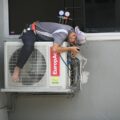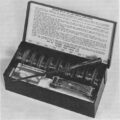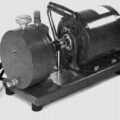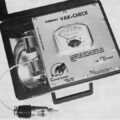PSYCHROMETRIC PROPERTIES
The properties of moist air are called psychrometric properties and the subject which deals with the behaviour of moist air is known as psychrometry.
Moist air is a mixture of dry air and water vapour. They form a binary mixture. A mixture of two substances requires three properties to completely define its thermodynamic state, unlike a pure substance which requires only two. One of the three properties can be the composition. Water vapour is present in the atmosphere at a very low partial pressure. At this low pressure and atmospheric temperature, the water vapour behaves as a perfect gas. The partial pressure of dry air is also below one atmosphere which may also be considered to behave very much as a perfect gas. The Gibbs- Dalton laws of perfect gas mixture can be applied to the moist air.
Since the water vapour part is continuously variable, all calculations in air- conditioning practice are based on the dry air part.
For calculating and defining the psychrometric properties, we may consider a certain volume V of moist air at pressure p and temperature T , containing ma kg of dry air and mv kg of water vapour as shown in Figure 6.3. The actual temperature t of moist air is called the dry bulb temperature (DBT). The total pressure p which is equal to the barometric pressure is constant.
Specific Humidity or Humidity Ratio
Specific or absolute humidity or humidity ratio or moisture content is defined as the ratio of the mass of water vapour to the mass of dry air in a given volume of the mixture. It is denoted by the symbol ω.
Dew Point Temperature
The normal thermodynamic state 1 as shown in the Figure 6.4 (a) of moist air is considered as unsaturated air. The water vapour existing at temperature T of the mixture and partial pressure pv of the vapour in the mixture is normally in a super heated state.
If a sample of such unsaturated moist air containing superheated water vapour is cooled (at constant pressure),the mixture will eventually reach the saturation temperature td of water vapour corresponding to its partial pressure pv, at which point the first drop of dew will be formed, i.e., the water vapour in the mixture will start condensing. This temperature td is called the dew point temperature (DPT).
Thermodynamic State of Water Vapour in Moist Air
Moisture can be removed from humid air by bringing the air in contact with a cold surface or cooling coil whose temperature is below its dew point temperature. During the process of cooling, the partial pressure pv of water vapour and specific humidity ω remain constant until the vapour starts condensing.
Degree of Saturation
Consider the water vapour in the super heated thermodynamic state 1 in unsaturated moist air representing the control volume V. the water vapour exists at the dry bulb temperature T of the mixture and partial pressure pv as shown in the Figure 6.4 (b).
An Imaginary Isothermal Process Showing the Change of State of Water Vapour
Now consider that more water vapour is added in this control volume V at temperature T itself. The partial pressure pv will go on increasing with the addition of water vapour until it reaches a value ps corresponding to state 2 in Figure 6.4 after which it cannot increase further as ps is the saturation pressure or maximum possible of water at temperature T. the thermodynamic state of water vapour is now saturated at point 2. the air containing moisture in such a state is called saturated air. In this state the air is holding the maximum amount of water vapour( the specific humidity being ωs, corresponding to the partial pressure ps ) at temperature T of the mixture. The maximum possible specific humidity, ωs at temperature T is thus
The ratio of the actual specific humidity ω to the specific humidity ωs of saturated air at temperature T is termed as the degree of saturation denoted by the symbol μ.
Thus the degree of saturation is a measure of the capacity of air to absorb moisture.
Relative Humidity
The relative humidity is defined as the ratio of the mole fraction of water vapour in moist air to mole fraction of water vapour in saturated air at the same temperature and pressure. From perfect-gas relationships another expression for is
Enthalpy of Moist Air
According to Gibb‟s law, the enthalpy of a mixture of perfect gases can be obtained by the net summation of the enthalpies of the respective constituents. Therefore the enthalpy of the moist air h is equal to the summation of the enthalpies of dry air and of the water vapour associated with the air. Hence,
h=ha+ whv
Per kg of dry air, where ha is the enthalpy of the dry air part and whv is the enthalpy of the water vapour part. The change in enthalpy of a perfect gas being considered as a function of temperature only, the enthalpy of the dry air part above a datum of 00C is expressed as:
ha=Cpa t=1.005 t kJ/kg (=0.24 t Btu/lbm where t is in 0F) where Cp= 1.005 kJ/kg.K is the specific heat of dry air, and t is the dry-bulb temperature of air in 0C.
Assuming the reference state enthalpy as zero for saturated liquid at 00C, the enthalpy of water vapour at point A in the above Figure can be expressed as:
hv= hA= Cpw td+ (hfg)d + Cpv (t – td) kJ/kg where Cpw= specific heat of liquid water
td = dew point temperature
(hfg)d = latent heat of vaporization at DPT
Cpv=specific heat of superheated vapour
Taking the specific heat of liquid water as 4.1868 kJ/kg K and that of water vapour as 1.88kJ/kg K, in the range 0 to 600C, we have
hv=4.1868 td + (hfg)d + 1.88 (t –td)
At low pressure for an ideal gas, the enthalpy is a function of temperature only. Thus in Figure
6.5 the enthalpies at point B and C are also the same as the enthalpy at A. Accordingly, enthalpy of water vapour at A, at DPT of td and DBT of t, can be determined more conveniently by the following two methods:
- hA = hC = (hg)t
- hA = hB=(h ) o + Cpv( t – 0)
fg 0 C
Evaluation of Enthalpy of Water Vapour Part
Using second expression and taking the latent heat of vaporization of water at 00C as 2501 k/kgK, we obtain the empirical expression for the enthalpy of the water vapour part
hv=2501 + 1.88t kJ/kg
And combining, we have the enthalpy of moist air
h =1.005t + ω(2500 + 1.88t) kJ/kg d.a
HUMID SPECIFIC HEAT
It is the specific heat of moist air (1 + ω) kg per kg of dry air.
WET BULB TEMPERATURE (WBT)
A psychrometer comprises of a dry bulb thermometer and a wet bulb thermometer. The dry bulb thermometer is directly exposed to the air and measures the actual temperature of air and is called dry bulb temperature. When the thermometer bulb is surrounded by a wet cloth exposed to the air. The temperature which is measured by the wick-covered bulb of such a thermometer indicates the temperature of liquid water in the wick and is called the wet bulb temperature. It is denoted by the symbol t’ .
The difference between the dry bulb and wet bulb temperatures is called wet bulb depression
(WBD).
WBD = (t – t’ )
If the ambient air is saturated, i.e. the RH is 100 per cent, then there will be no evaporation of water on the bulb and hence WBT and DBT will be equal. The WBT is an indirect measure of the dryness of air.
ADIABATIC SATURATION AND THERMODYNAMIC WET BULB TEMPERATURE
The thermodynamic wet bulb temperature or adiabatic saturation temperature is the temperature at which the air can be brought to saturation state, adiabatically, by the evaporation of water into the flowing air.
The equipment used for the adiabatic saturation of air, in its simplest form, consists of an insulated chamber containing adequate quantity of water. There is also an arrangement for extra water (known as make-up water) to flow into the chamber from its top, as shown in Figure
Adiabatic Saturation of Air
Let the unsaturated air enters the chamber at section 1. As the air passes through the chamber over a long sheet of water, the water evaporates which is carried with the flowing stream of air, and the specific humidity of the air increases. The make up water is added to the chamber at this temperature to make the water level constant. Both the air and water are cooled as the evaporation takes place. This process continues until the energy transferred from the air to the water is equal to the energy required to vaporise the water. When steady conditions are reached, the air flowing at section 2 is saturated with water vapour. The temperature of the saturated air at section 2 is known as thermodynamic wet bulb temperature or adiabatic saturation temperature.
The adiabatic saturation process can be represented on T-s diagram as shown by the curve 1-2 in Figure 6.7.
During the adiabatic saturation process, the partial pressure of vapour increases, although the total pressure of the air-vapour mixture remains constant. The unsaturated air initially at dry bulb temperature td1 is cooled adiabatically to dry bulb temperature td2 which is equal to the adiabatic saturation temperature tw. It may be noted that the adiabatic saturation temperature is taken equal to the wet bulb temperature for all practical purposes.
Let h1 = Enthalpy of unsaturated air at section 1, W1= Specific humidity of air at section 1, h2,
W2 = Corresponding values of saturated air at section 2, and
hfw= Sensible heat of water at adiabatic saturation temperature. Balancing the enthalpies of air at inlet and outlet (i.e. at sections 1 and 2), h1 + (W2 – W1) hfw= h2
h1 – W1 hfw = h2 – W2 hfw
The term (h2 – W2 hfw) is known as sigma heat and remains constant during the adiabatic process
We know that h1 = ha1 + W1hs1 h2 = ha2 + W2hs2
where
ha1 = Enthalpy of 1 kg of dry air at dry bulb temperature tdl, hs1 = Enthalpy of superheated vapour at t per kg of vapour, ha2 = Enthalpy of 1 kg of air at wet bulb temperature tw , and
hs2 = Enthalpy of saturated vapour at wet bulb temperature tw per kg of vapour.
Now the equation may be written as:
PSYCHROMETRIC CHART
All data essential for the complete thermodynamic and psychrometric analysis of air- conditioning processes can be summarized in a psychrometric chart. At present, many forms of psychrometric charts are in use. The chart which is most commonly used is the ω-t chart, i.e. a chart which has specific humidity or water vapour pressure along the ordinate and the dry bulb temperature along the abscissa. The chart is normally constructed for a standard atmospheric pressure of 760 mm Hg or 1.01325 bar, corresponding to the pressure at the mean sea level.
Saturation Line
The saturation line represents the states of saturated air at different temperatures. As an example of fixing such a state on the chart, consider an atmosphere A at 20 oC and saturation
6.9. From the steam tables at 20 oC, water vapour pressure
Saturated Air at 20 oC
ps= pv = 17.54 mm Hg =2342 N/m2 Partial pressure of dry air pa=p –
pv =101325-2342 = 98983 N/m2
Specific humidity at 20 oC saturation
Knowing t and ω, point a can be plotted. In a similar manner, saturation states at other temperatures can
also be plotted to draw the saturation line on the psychrometric chart.
Relative Humidity Lines
The relative humidity is defined as the ratio of the mole fraction of water vapour in moist air to mole fraction of water vapour in saturated air at the same temperature and pressure. From perfect-gas relationships another expression is
The relative humidity lines are curved lines and follow the saturation curve.
Generally, these lines are drawn with values 10%, 20%, 30% etc.and up to 100%.The saturation curve represents 100% relative humidity. The values of relative humidity lines are generally given along the lines themselves
Relative Humidity Lines
The lines on psychrometric chart for any other desired value of RH can he constructed as follows. Taking 50 per cent RH as an example, the point on the 20°C line corresponding to this RH must be at the intersection C (Figure) with the line representing a vapour pressure of
Constant Specific Volume Lines
The constant specific volumes lines are obliquely inclined straight lines and uniformly spaced as shown in Figure These lines are drawn up to the saturation curve. To establish points on a line of constant specific volume, 0.90 m3/kg for example, From the perfect-gas equation, the specific volume v is substitute 0.90 for v, the barometric pressure for pt, and at arbitrary values of T solve for ps. the pairs of ps and t values then describe the line of constant v.
Specific Volume Lines
Constant Thermodynamic Wet Bulb Temperature Lines
Wet Bulb Temperature Lines
The wet bulb temperature lines are inclined straight lines and non-uniformly spaced as shown in Figure 6.13 any point on the saturation curve, the dry bulb and wet bulb temperatures are equal.
The values of wet bulb temperatures are generally given along the saturation curve of the chart
Constant Enthalpy Lines
The enthalpy (or total heat) lines are inclined straight lines and uniformly spaced
16.14. These lines are parallel to the wet bulb temperature lines, and are drawn up to the saturation curve. Some of these lines coincide with the wet bulb temperature lines also.



